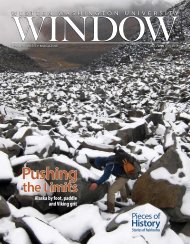BEFORE THEY’RE GONE
BEFORE THEY'RE GONE - WINDOW - The magazine for WWU
BEFORE THEY'RE GONE - WINDOW - The magazine for WWU
Create successful ePaper yourself
Turn your PDF publications into a flip-book with our unique Google optimized e-Paper software.
<strong>BEFORE</strong><br />
<strong>THEY’RE</strong><br />
<strong>GONE</strong><br />
Story by<br />
Doug McInnis<br />
Eric Dinerstein (’75), chief scientist for the<br />
World Wildlife Fund, is part of a global effort to save<br />
the habitat of wild tigers<br />
Despite what you may have heard, there are plenty of tigers in<br />
the world – in places like Texas.<br />
But in the wild regions of Asia, where tigers are meant to<br />
be, they are endangered. Just 3,200 survive in a region that<br />
once supported 100,000, says Eric Dinerstein (’75, Ecosystems<br />
Analysis), the chief scientist for the World Wildlife Fund.<br />
More tigers can be found on Texas game ranches, he says.<br />
Dinerstein has tracked the big cat’s fate since he participated in<br />
a tiger census more than 30 years ago as a Peace Corps volunteer<br />
in Nepal. He’s now one of the world’s most influential wildlife<br />
scientists, and part of a multi-national movement to save the tiger.<br />
The cat’s plight stems both from poaching and from human<br />
development of what was once prime tiger habitat. To reverse the<br />
tiger’s population crash, wildlife scientists say Asian nations must<br />
stop the poaching and expand the habitat. Dinerstein believes<br />
the cat can be saved, in part because other species have bounced<br />
back after approaching extinction. Just 100 southern white rhinos<br />
survived in Africa in 1900. Today, there are more than 20,000.<br />
“Even the most endangered mammals on Earth can make dramatic<br />
recoveries as long as we protect them and preserve enough habitat,”<br />
Dinerstein says.<br />
Dinerstein was an unlikely candidate for a career in wildlife<br />
science. He spent his childhood indoors, reading and watching<br />
old movies. He foresaw a career as a filmmaker as he headed for<br />
college. Yet, within a few years, he found himself in the Himalayan<br />
kingdom of Nepal, living in a tent, sometimes riding an elephant<br />
for transport, and co-existing with some of the most dangerous<br />
creatures on Earth.<br />
One memorable night, he and his Peace Corps tent mate<br />
awoke to the sound of crunching. They peered through the tent’s<br />
Continued on page 20<br />
18








